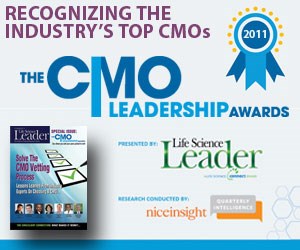What It Takes To Be A 5-Category CMO Leadership Award Winner

By Rob Wright, Chief Editor, Life Science Leader
Follow Me On Twitter @RfwrightLSL

Prior to the Thanksgiving Holiday, I had the opportunity to sit down with several members of Therapure Biopharma executive leadership team prior to taking a tour of the company’s Mississauga, Ontario (near Toronto) manufacturing facility. For three years in a row, Therapure has been recognized as a CMO Leadership Award Winner — the past two (2012 & 2013) in all five categories. This rare distinction has been made by only two CMOs — Norwich Pharma Services and Therapure. I wanted to know what Therapure president and CEO, Nick Green, has been “putting in the water” to achieve such impressive and consistent results, given the data-driven nature of this particular awards program. According to Green, it starts with process intimacy.
Intimacy Of The Manufacturing Process
The term process intimacy is a phrase I first heard during an interview I conducted with Jim Robinson, VP of vaccine manufacturing at Merck for the December 2012 cover feature. Robinson stated it this way. “Process intimacy is much more than knowing the process technically. When you’re on the shop floor of an industrial operation, it has a rhythm, a feel, sound, and smell.” Green agrees, sharing with me the importance of having a sense for the rhythm on Therapure’s shop floor. He counts on the Therapure manufacturing team to have such a deep and knowledgeable understanding of the process that it results in the creation of a relationship between the personnel and the process. And though both Merck and Therapure describe the importance of understanding the manufacturing process intimately, there is a difference when you are involved in an outsourced model and manufacturing a product on behalf of someone else. According to Green, this requires more than just having manufacturing process intimacy, but customer intimacy. “It is a level of intimacy where the customer feels and thinks they own part of your company,” he states. One of the best ways to do this is not by minimizing client experience, but putting processes in place so as to capture that information, and to do so proactively. It is this self-critical approach for why Therapure recently began introducing Lean Six Sigma into its manufacturing process.
If It Isn’t Broke, Break It
One of my former bosses at Organon Pharmaceuticals used to say, “If it isn’t broke, break it.” Meaning, just because a process may be working well, doesn’t mean you should sit back on your laurels as if it’s business as usual. Rather, you should be striving for continuous improvement. This can only be done if you are constantly willing to challenge your own status quo and assess your approach to a process. Green stated to me that because Therapure, which began operating as a contract development and manufacturing organization (CDMO) in 2008, has experienced such significant growth, the company decided to implement Lean Six Sigma as a means of raising the bar rather than taking comfort in its solid manufacturing record. The leadership team and Green are taking a disciplined approach in identifying and collecting data as to what current processes need to be improved, starting with hiring a Six Sigma-certified Black Belt and creating an in-house training program.
After the CMO Leadership Awards are announced I am frequently asked why some companies were recognized and others weren’t — a question usually posed by employees of companies which, unfortunately, didn’t win. Because the awards are data driven through the gathering of research by an independent company to Life Science Leader, it is usually a fairly easy question to answer. But rather than ask why you didn’t win, perhaps you should ask, how do companies like Therapure and Norwich consistently win? Answer, if it isn’t broke, break it. Interested in learning more about implementing Lean Six Sigma at your organization? Here is a great place to start, which includes the eight lessons for a successful deployment.
